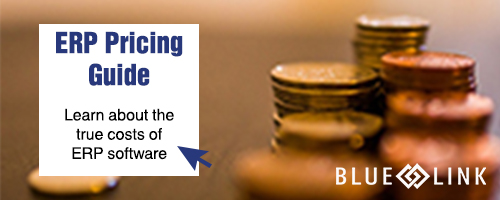If you are in the market for ERP software, it is important to prepare a proper budget before you start engaging with software vendors. However, keep in mind that while budget is an important part of the software search, it should not be the main deciding factor when it comes to choosing a solution. Budget should be considered in conjunction with comparing software features, industry experience, after-sale support, and your comfort level with the software company and its people.
In order to determine an appropriate budget, the first thing you need to do is figure out what type of solution is the right fit, as this will dictate what features are included, how much the system costs, the opportunities for automation and the level of software support you can expect.
- Are you looking for software to manage one specific area of functionality, such as inventory management or barcode scanning?
- Are you looking to integrate a new solution with an existing accounting system?
- Are you looking for an all-in-one ERP system?
Determining which option makes the most sense will allow you to then prepare a proper budget. And if you’re not sure, it is a good idea to start speaking with vendors to get a feel for what is available in the market – especially if it’s been a while since you’ve looked. For the purpose of this article, we will share information on how to prepare a budget for ERP software - an all-in-one system designed to replace any existing inventory or accounting software currently in use.
Determine the number of users.
The first step to creating a software budget is determining how many of your employees need to use the software as many vendors charge a per-user fee. For cloud-based solutions, this means how many employees need an actual login and password, and does not limit access to only one computer. To get a feel for the number of users, ask yourself the following questions:
- Which employees need access to the system? This includes people dealing with accounting, invoicing, sales orders, purchasing and shipping.
- What information do these users need access to and what tasks are they responsible for? Are some of these users remote salespeople? Are some of these users picking product in the warehouse?
It is important to know what sort of information each type of user requires from the system and the functionality they need to do their job. For example, some ERP vendors provide tools for employees who don’t need full access to the software – for example, remote sales apps for salespeople on the road, or barcode scanning tools for warehouse staff.
Does your business require any industry-specific functionality?
Determining functionality is another area that will impact your budget. While ERP software will include all your basic inventory management and accounting features out-of-the-box, some vendors such as Blue Link, also provide industry-specific features that you can choose to turn on. These types of features are usually unique to specific industries and therefore can be an additional cost. A good example of this is lot tracking. Lot tracking is functionality specific to companies that need to track specific lots or batches of products for inventory management, lot costing, recall purposes and/or to meet regulatory requirements – such as food distributors and pharmaceutical distributors.
Do you need to purchase new hardware or other equipment?
One of the common reasons why a company decides to replace its software is because they are using outdated equipment or systems. If this is the case, you will need to budget for hardware purchases in addition to new software. This could include new computers, laptops and monitors, new operating system software such as the latest version of Windows, or perhaps other tools for your team such as tablets for your salespeople or barcode scanning equipment for the warehouse.
What about implementation costs?
Implementation costs are the one-time fees associated with getting your company up and running on a new system. These costs are paid upfront, and they make up a significant portion of overall costs and need to be budgeted for appropriately. Implementation costs typically include the cost of user training, system set-up and configuration, and data migration. However, many vendors vary in the implementation services they provide, and may not provide the same level of training or data migration. You also need to be honest with yourself about the amount of work you and your team can do. For example, it may seem enticing to manually import data from your existing software into a new system as a means to cut costs, but this requires that an employee spend a significant amount of time away from their regular duties to complete the work. And what happens if you run into an issue or decide that you want to clean up your data? Therefore, you want to make sure you’re budgeting for all implementation services. Other considerations to keep in mind when it comes to the implementation is…
Training
- Do your employees have experience using software? Are they tech-savvy and able to learn a new system quickly? Are employees being trained in multiple areas of the software?
Data Migration
- How many systems are you migrating data from? Are you moving data from spreadsheets, your accounting software and your online store? Is this data stored in different file formats? Do you want to clean up your data before you move it? For example, removing duplicate data or incorrect data?
Remember, purchasing an all-in-one ERP solution for your business will be one of the biggest business decisions you make. And rightly so, as a proper solution will be able to streamline operations across all departments, automate processes and eliminate manual data entry and the associated human errors with doing so. Make sure you budget appropriately for a new solution, using the above information as guidance.











